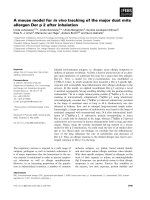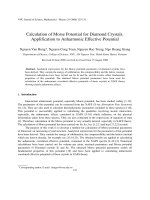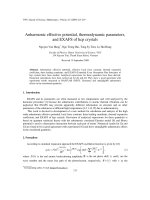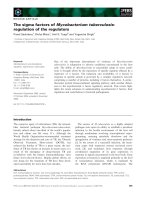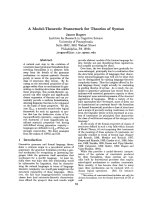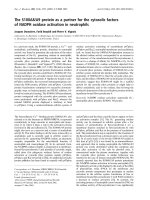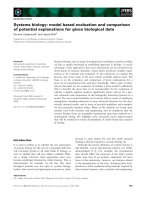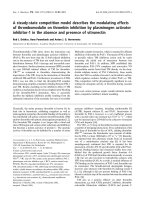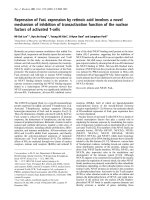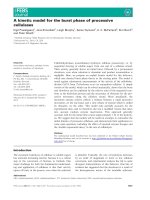Anharmonic Correlated Debye Model high-order Expanded Debye-Waller Factors of BCC Crystals - Applica to Metallic Wolfram
Bạn đang xem bản rút gọn của tài liệu. Xem và tải ngay bản đầy đủ của tài liệu tại đây (161.18 KB, 7 trang )
<span class='text_page_counter'>(1)</span><div class='page_container' data-page=1>
Anharmonic Correlated Debye Model high-order Expanded
Debye-Waller Factors of BCC Crystals:
Application to Metallic Wolfram
Nguyen Van Hung
*<sub>, Trinh Thi Hue, Nguyen Bao Trung, Nguyen Cong Toan</sub>
<i>Faculty of Physics, VNU University of Science, 334 Nguyen Trai, Hanoi, Vietnam</i>
Received 15 January 2017
Revised 16 February 2017; Accepted 20 March 2017
<b>Abstract: Anharmonic correlated Debye model is derived for Debye-Waller factors of bcc </b>
(body-centered cubic) crystals presented in terms of cumulant expansion up to the fourth order. The
many-body effects are taken into account in the present one-dimensional model based on the
anharmonic effective potential that includes interactions of absorber and backscatterer atoms with
their first shell near neighbors, where Morse potential is assumed to describe the single-pair
atomic interaction. Analytical expressions for dispersion relation, correlated Debye frequency and
temperature and four first temperature-dependent XAFS (X-ray absorption fine structure)
cumulants of bcc crystals have been derived using the many-body perturbation approach.
Numerical results for W are found to be in good agreement with experiment.
<i>Keywords: Debye-Waller factor, effective potential, correlated Debye model, bcc crystals. </i>
<b>1. Introduction</b>
X-ray Absorption Fine Structure (XAFS) has developed into a powerful technique for providing
information on local atomic structure and thermal effects of the substances [1-14]. The f ormalism for
including anharmonic effects in XAFS is often based on the cumulant expansion approach [1] from
which the expression for anharmonic XAFS is given by [2]
<i>n</i>
<i>n</i>
<i>n</i>
<i>n</i>
<i>ik</i>
<i>ikR</i>
<i>e</i>
<i>e</i>
<i>k</i>
<i>F</i>
<i>k</i> <i>i</i> <i>k</i>
<i>kR</i>
<i>k</i>
<i>R</i>
)
(
!
)
2
(
2
exp
Im
)
( <sub>2</sub> ( )
)
(
/
2
<b> (1)</b>
where
<i> is net phase shift, λ is mean free path, k is wave number of photoelectron, R</i> <i>r</i> with<i>r being the instantaneous bond length between absorber and backscatterer atoms, and σ</i>(n)<sub> (n = 1, 2, 3,</sub>
4, …) are the cumulants describing the high-order expanded Debye-Waller factors (DWFs).
Hence, cumulants (the moments in anharmonic expansion of DWFs) are very important for the
accurate structural determinations (e.g., the coordination numbers and the atomic distances) from
XAFS experiment, where the even cumulants contribute to the amplitude, the odd one to the phase of
XAFS and for small anharmonicities, it is sufficient to keep the third and fourth cumulant terms [3].
Many efforts have been made to develop procedure for the calculation and analysis of XAFS
</div>
<span class='text_page_counter'>(2)</span><div class='page_container' data-page=2>
cumulants using the classical [4,5] and quantum [6-12] theories. Unfortunately, there is still no
theoretical result for bcc crystals while their experimental results are available [13].
The purpose of this work is to derive an anharmonic correlated Debye model (ACDM) for
studying the high-order expanded DWFs for the local vibrational amplitudes in XAFS of bcc crystals.
Our contributions to this work presented in Sect. 2 are the derivations of firstly, the anharmonic
effective potential for bcc crystals expanded up to the fourth order based on the first shell near
neighbor contribution approach (FNNCA) instead of the single-bond (SB) [6] and single-pair (SP) [7]
potentials, and secondly, the analytical expressions of four first temperature-dependent XAFS
cumulant for bcc crystals using the many-body perturbation approach (MBPA) [14], the derived
dispersion relation and the obtained anharmonic effective potential parameters, where Morse potential
is assumed to describe the single-pair atomic interaction. Numerical results for W are compared to
experiment [13] which show good agreement.
<b>2. Anharmonic correlated Debye model for bcc crystals</b>
<i>2.1. Anharmonic interatomic effective potential of bcc crystals</i>
<i>The anharmonic interatomic effective potential expanded up to the fourth order in the present</i>
theory for bcc crystals can be expressed as
2 3 3 4 4,
02
1
<i>r</i>
<i>r</i>
<i>x</i>
<i>x</i>
<i>k</i>
<i>x</i>
<i>k</i>
<i>x</i>
<i>k</i>
<i>x</i>
<i>V</i>
<i><sub>eff</sub></i>
<i><sub>eff</sub></i>
<i><sub>eff</sub></i>
<i><sub>eff</sub></i>
, (2)
where
<i>k</i>
<i>eff</i> <i><sub>is the effective local force constant, r and r</sub></i>0 are the instantaneous and equilibrium
distances between absorber and backscatterer atoms,
<i>k</i>
3<i>eff</i> <sub> and </sub><i>k</i>
4<i>eff</i> <sub> are the anharmonic parameters</sub>giving an asymmetry of the anharmonic effective potential.
For bcc crystals, each atom is bonded to its 8 first shell near neighbors so that in the present
FNNCA the oscillation of a single bond pair of atoms (e.g., absorber and backscatterer) is influenced
by their first shell near neighbors. Therefore, the anharmonic interatomic effective potential in the
present ACDM defined based on an assumption in the center-of-mass frame of single bond pair of
absorber and backscatterer atoms, has the form
6
6
6
6
2
2
)
(
<i>x</i>
<i>V</i>
<i>x</i>
<i>V</i>
<i>x</i>
<i>V</i>
<i>x</i>
<i>V</i>
<i>x</i>
<i>V</i>
<i><sub>eff</sub></i>, (3)
which is the sum over not only the term V(x) describing the pair-interaction between absorber and
backscatterer atoms but also the other terms describing the projections of their pair-interactions with
14 first shell near neighbors of bcc crystals along the bond direction excluding the absorber and
backscatterer themselves whose contributions are already described by V(x).
Applying Morse potential expanded up to the fourth order as
<sub></sub> <sub></sub> <sub></sub> <sub></sub>
2 2 2 3 3 4 4
12
7
1
2<i>e</i> <i>D</i> <i>x</i> <i>x</i> <i>x</i>
<i>e</i>
<i>D</i>
<i>x</i>
<i>V</i> <i>x</i> <i>x</i> <sub></sub> <sub></sub> <sub></sub>
(4)
to Eq. (3) and comparing the result to Eq. (2), we obtain the values of
<i>k</i>
<i>eff</i>,
<i>k</i>
3<i>eff</i>,
<i>k</i>
4<i>eff</i><sub> for bcc</sub></div>
<span class='text_page_counter'>(3)</span><div class='page_container' data-page=3>
4
4
3
3
2
2592
1715
,
4
3
,
3
11 <sub></sub> <sub></sub> <sub></sub>
<i>D</i>
<i>k</i>
<i>D</i>
<i>k</i>
<i>D</i>
<i>keff</i> <i>eff</i> <i>eff</i>
, (5)
where α describes the width of the potential and D is dissociation energy.
Hence, the anharmonic effective potential for bcc crystals of Eq. (3) has resulted as
2 2 3 3 4 42592
1715
4
3
6
11
<i>x</i>
<i>D</i>
<i>x</i>
<i>D</i>
<i>x</i>
<i>D</i>
<i>x</i>
<i>V<sub>eff</sub></i>
, (6)
which is different from the SB and SP potentials denoted by SPP containing only V(x) describing
the pair-interaction between absorber and backscatterer atoms in the form
2 2 3 3 4 412
7
<i>x</i>
<i>D</i>
<i>x</i>
<i>D</i>
<i>x</i>
<i>D</i>
<i>x</i>
<i>V</i>
<i>x</i>
<i>VSP</i>
. (7)
Note that the above mentioned lattice contributions based on the FSNNCA, to the oscillation
between absorber and backscatterer atoms described by the projections of their pair-interactions with
14 first shell near neighbors along the bond direction, make it possible to take into account the
many-body effects in the present one-dimensional model for bcc crystals.
<i>2.2. XAFS cumulants of bcc crystals</i>
In order to include the anharmonic effects, Hamiltonian of the system is written in the summation
of the harmonic and anharmonic components,
<i>H</i>
0<sub> and </sub><i>H</i>
<i>a</i><sub>, respectively</sub><i>q</i>
<i>c</i>
<i>a</i>
<i>a</i>
<i>H</i>
<i>H</i>
<i>H</i>
<i>H</i>
<i>H</i>
<i>H</i>
<sub>0</sub>
,
, (8)
<i>which are used for deriving analytical expressions of the cumulants where H</i>0 containing the local
force constant
<i>k</i>
<i>eff<sub> is used for derivation of second cumulant, the cubic term H</sub></i>c containing
<i>k</i>
3<i>eff</i> is<i>used for derivation of the first and third cumulants, and Ha consisting of H</i>c<i> and the quartic term H</i>q
containing
<i>k</i>
4<i>eff</i> <sub> is used for derivation of the fourth cumulant of bcc crystals.</sub>Derivation of the present ACDM for bcc crystals using the MBPA [14] is based on the dualism of
an elementary particle in quantum theory, i.e., its corpuscular and wave property. Then, we can
describe the system in Debye model involving all different frequencies up to the Debye frequency as a
system consisting of many bodies, i.e., of many phonons, each of which corresponds to a wave having
<i>frequency ω(q) and wave number q varied in the first BZ.</i>
For this purpose, the displacement <i>un</i>'<i>s<sub> in the parameter x in terms of the displacement of nth</sub></i>
atom <i>un</i><sub> of the one dimensional chain described</sub><sub>by</sub>
<i>n</i>
<i>n</i>
<i>n</i>
<i>u</i>
<i>u</i>
<i>x</i>
<sub>1</sub>
<sub> (9)</sub>is related to the phonon displacement operators <i>Aq</i><sub> [15] in the form</sub>
<i>q</i>
<i>q</i>
<i>iqan</i>
<i>n</i> <i>A</i>
<i>q</i>
<i>e</i>
<i>NM</i>
<i>u</i>
)
(
2
, <i>Aq</i> <i>A</i><i>q</i>,
<i>Aq</i>,<i>Aq</i>'
0 <sub> (10) </sub></div>
<span class='text_page_counter'>(4)</span><div class='page_container' data-page=4>
<sub> </sub>
1
2
,
<i>iqan</i> <i><sub>e</sub>iqa</i>
<i>q</i>
<i>NM</i>
<i>q</i>
<i>f</i>
<i>A</i>
<i>q</i>
<i>f</i>
<i>e</i>
<i>x</i>
<i>q</i> <i>q</i>
<i>n</i> <sub></sub>
, (11)
<i>where N is atomic number, M is the mass of composite atoms and a is lattice constant.</i>
<i> The frequency ω(q) contained in Eq. (11) and then in all cumulant expressions derived for the</i>
vibration between absorber and backscatterer atoms in XAFS process describes the dispersion relation.
Using the local force constant of the first equation of Eqs. (5), it has resulted as
<i>a</i>
<i>q</i>
<i>qa</i>
<i>M</i>
<i>D</i>
<i>q</i>
,
2
sin
3
11
2
. (12)
At the bounds of the first Brillouin zone (BZ of the linear chain,
<i>q</i>
/
<i>a</i>
, the frequency hasmaximum so that from Eq. (12) we obtain the correlated Debye frequency
<i>D</i><sub> and temperature </sub>
<i>D</i>for bcc crystals in the form
<i>B</i>
<i>D</i>
<i>D</i>
<i>D</i>
<i>k</i>
<i>M</i>
<i>D</i>
<sub></sub>
, 3
11
2
, (13)
where <i>kB</i><sub> is Boltzmann constant.</sub>
Using the above results in the MBPA [14], we have derived the analytical expressions for XAFS
DWFs presented in terms of cumulant expansion up to the fourth order for bcc crystals.
The first cumulant describing the net thermal expansion or disorder in XAFS theory has resulted
as
<sub> </sub>
<sub> </sub>
exp
, 1/ .,
484
81
,
1
1
)
1
(
0
2
2
0
)
1
(
0
/
0
)
1
(
0
1
<i>T</i>
<i>k</i>
<i>q</i>
<i>q</i>
<i>Z</i>
<i>D</i>
<i>a</i>
<i>dq</i>
<i>q</i>
<i>Z</i>
<i>q</i>
<i>Z</i>
<i>q</i>
<i>x</i>
<i>T</i>
<i>B</i>
<i>a</i>
(14)
Here, σ2<sub> is second cumulant describing the mean square relative displacement (MSRD) and has the</sub>
following form
<sub> </sub>
2 <sub>2</sub>0
/
0
2
0
2
2
22
3
,
1
1
)
(
<i>D</i>
<i>a</i>
<i>dq</i>
<i>q</i>
<i>z</i>
<i>q</i>
<i>z</i>
<i>q</i>
<i>x</i>
<i>T</i>
<i>a</i>
. (15)
The third cumulant is the mean cubic relative displacement (MCRD) describing the asymmetry of
the pair distribution function in XAFS theory and has resulted as
</div>
<span class='text_page_counter'>(5)</span><div class='page_container' data-page=5>
The fourth cumulant describes the anharmonic contribution to XAFS amplitude. It has been
derived and given by
<sub> </sub>
.,
2
10
165
,
1
1
1
1
6
1
1
1
1
8
1
3
3
2
1
4
4
3
3
3
3
4
)
4
(
0
4
3
2
1
4
3
4
3
2
1
4
3
2
1
4
3
2
1
3
2
1
4
3
2
1
4
3
2
1
4
3
2
1
4
3
2
1
)
(
/
/
3
/
0
2
/
0
1
)
4
(
0
2
2
4
4 1 1 2
<i>q</i>
<i>q</i>
<i>q</i>
<i>q</i>
<i>D</i>
<i>a</i>
<i>q</i>
<i>q</i>
<i>q</i>
<i>q</i>
<i>q</i>
<i>q</i>
<i>q</i>
<i>Z</i>
<i>q</i>
<i>Z</i>
<i>q</i>
<i>Z</i>
<i>q</i>
<i>Z</i>
<i>q</i>
<i>Z</i>
<i>q</i>
<i>Z</i>
<i>q</i>
<i>Z</i>
<i>q</i>
<i>Z</i>
<i>q</i>
<i>q</i>
<i>q</i>
<i>q</i>
<i>q</i>
<i>q</i>
<i>q</i>
<i>q</i>
<i>Z</i>
<i>q</i>
<i>Z</i>
<i>q</i>
<i>Z</i>
<i>q</i>
<i>Z</i>
<i>q</i>
<i>Z</i>
<i>q</i>
<i>Z</i>
<i>q</i>
<i>Z</i>
<i>q</i>
<i>Z</i>
<i>q</i>
<i>q</i>
<i>q</i>
<i>q</i>
<i>q</i>
<i>q</i>
<i>q</i>
<i>q</i>
<i>dq</i>
<i>dq</i>
<i>dq</i>
<i>x</i>
<i>x</i>
<i>T</i>
<i>q</i>
<i>q</i>
<i>a</i>
<i>a</i>
<i>q</i>
<i>a</i>
<i>a</i>
(17)
Note that in the above expressions for the cumulants of bcc crystals, 0(4)
)
3
(
0
2
0
)
1
(
0
,
,
,
<sub> are </sub>zero-point energy contributions to the first, second, third and fourth cumulant, respectively, and they have
<i>been obtained for the case of large phonon number, when the summation over q is replaced by the</i>
corresponding integral in the first BZ.
<b>3. Numerical results and discussions</b>
Now the expressions derived in the previous section are applied to numerical calculations for W
using its Morse potential parameters [16] D = 0.979 eV, α = 1.441 Å-1<sub>. </sub>
Note that the correlated Debye frequency and temperature (Tab. 1), anharmonic effective potential
(Fig. 1a), dispersion relation (Fig. 1b) and XAFS cumulants (Figs. 2 – 3) of W calculated using the
present theory agree well with the experimental values [13] and are quite different from those
calculated using the SPP (Tab. 1, Fig. 1 - 2). Based on Eq. (1) they contribute to getting the accurate
information on W, a bcc crystal, from XAFS experiment.
Table 1. Debye frequency ω<i>D</i> and temperature θ<i>D</i> of W calculated using the present theory compared to the
experimental values (Expt.) [13] and to those calculated using the SPP.
<i>D</i>
<sub>(10</sub>13<sub>Hz)</sub>
<i><sub>D</sub></i><sub>(K)</sub>Crystal Present Expt. [13] SPP Present Expt. [13] SPP
</div>
<span class='text_page_counter'>(6)</span><div class='page_container' data-page=6>
Figure 1. a) Anharmonic effective potential and b) dispersion relation of W calculated using the present theory
compared to experiment [13] and to those calculated using SPP parameters.
Figure 2. Temperature dependence of a) first cumulant σ(1)<sub>(T) and b) second cumulant σ</sub>2<sub>(T) </sub>
of W calculated using the present thery compared to the experimental values [13] and to those calculated
using the SPP parameters.
Figure 3. Temperature dependence of a) third cumulant σ(3)<sub>(T) and b) fourth cumulant σ</sub>(4)<sub>(T) of W calculated</sub>
using the present theory compared to the experimental values [13].
<b>4. Conclusions</b>
An ACDM has been derived for studying the anharmonic effective potential, DWF expanded
up to the fourth order and anharmonic effects in XAFS of bcc crystals. This leads to getting the
accurate information on their structural and other parameters taken from XAFS experiment.
The significant discrepancies of the results calculated using the SPP parameters with experiment
can be attributed to neglecting the many-body effects in the SPP so that they are able to be treated by
the present theory using the anharmonic effective potential.
</div>
<span class='text_page_counter'>(7)</span><div class='page_container' data-page=7>
<b>Acknowledgements</b>
This research is funded by the Vietnam National Foundation for Science and Technology
Development (NAFOSTED) under grant number 103.01-2015.10.
<b>References</b>
[1] E. D. Crozier, J. J. Rehr, and R. Ingalls, in X-ray Absorption, edited by D. C. Koningsberger and R. Prins (Wiley,
New York, 1988). Chap. 9.
[2] N. V. Hung, N. B. Duc, and R. R. Frahm, “A New Anharmonic Factor and EXAFS including Anharmonic
Contributions”, J. Phys. Soc. Jpn. 72 (2003) 1254.
[3] J. M. Tranquada and R. Ingalls, ”Extended X-ray-absorption fine-structure study of anharmonicity of CuBr”,
Phys. Rev. B 28 (1983) 3520.
[4] E. A. Stern, P. Livins, and Zhe Zhang, “Thermal vibration and melting from a local perspective”, Phys. Rev. B 43
(1991) 8850.
[5] N. V. Hung, T. S. Tien, N. B. Duc, and D. Q. Vuong, ”High-order expanded XAFS Debye-Waller factors of hcp
crystals based on ACEM“, Mod. Phys. Lett. B 28 (2014) 1450174.
[6] A. I. Frenkel and J. J. Rehr, ”Thermal expansion and X-ray-absorption fine-structure cumulants”, Phys. Rev. B
48 (1993) 585.
[7] T. Miyanaga and T. Fujikawa, “Quantum Statistical Approach to Debye-Waller Factor in EXAFS, EELS and
ARXPS. Application of Debye and Einstein Approximation”, J. Phys. Soc. Jpn. 63 (1994) 3683.
[8] N. V. Hung and J. J. Rehr, “Anharmonic correlated Einstein model Debye-Waller factors”, Phys. Rev. B 56
(1997) 43.
[9] M. Daniel, D. M. Pease, N. Van Hung, J. I. Budnick, “Local force constants of transition metal dopants in a
nickel host: Comparison to Mossbauer studies”, Phys. Rev. B 69 (2004) 134414.
[10] N. V. Hung, N. B. Trung, and B. Kirchner, “Anharmonic correlated Debye model Debye-Waller factors“,
Physica B 405 (2010) 2519.
[11] N. V. Hung, V. V. Hung, H. K. Hieu, R. R. Frahm, “Pressure effects in Debye-Waller factors and in EXAFS“,
Physica B 406 (2011) 456.
[12] N. V. Hung, C. S. Thang, N. C. Toan, H. K. Hieu, “Temperature dependence of Debye-Waller factors of
semiconductors”, VAC. 101 (2014) 63.
[13] I. V. Pirog and T. I. Nedoseikina, “Study of pair effective potentials in cubic metals”, Physica B 334 (2003) 123.
[14] G. D. Mahan, Many-Particle Physics (Plenum, New York, 1990) 2nd<sub> ed. </sub>
[15] A. A. Maradudin, Dynamical Properties of Solids, ed. by G. K. Horton and A. A. Maradudin (North Holland,
Amsterdam, 1974) Vol. 1, p. 1.
</div>
<!--links-->
